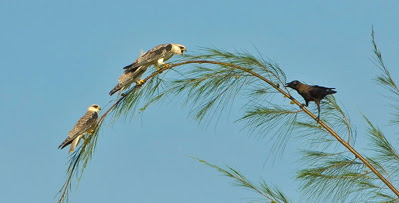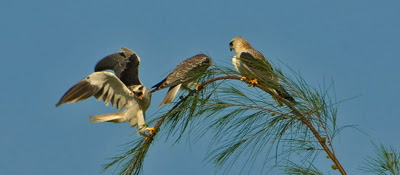The House Crow (Corvus splendens) is a rather aggressive bird (above). At slightly more than 40 cm from the tip of the bill to the end of the tail, this bird is up to 30% larger than the Black-shouldered Kite (Elanus caeruleus). The crow moves in small flocks whereas the kite is usually found singly or in pairs during nesting periods. Only outside the breeding season does the kite feeds and roosts communally. Thus in any confrontation between these two birds, the kite invariably ends up the loser. This is especially so during nesting when the kite is vulnerable to attacks by crows.
Allan Teo is one photographer-birder who has noticed the aggressiveness of the crows. In November 2006 he wrote in saying: “I observed many times that the poor Black-shouldered Kite is always getting harassed by House Crows and many raptors.“
Allan observed a single House Crow harassing the three juvenile kites (above). When one of the kites flew above and hovered around the crow, baring its talons in the process, the latter simply ignored it.
Allan also witnessed adult kites being harassed, possibly by Changable Hawk Eagle (Spizaetus cirrhatus) – that may well be juvenile Brahminy Kite (Haliastur indus) (above). Thankfully the attack was only a mock one that concluded with only nerves ruffled. There was another case of these kites being harassed by marsh harriers. He has also seen images of the Steppe Eagles (Aquila nipalensis) that appeared some months ago around the Changi reclaimed areas attacking the nest of the Black-shouldered Kites. In this case the kites managed to chase off the eagles.
Tang Hung Bun reported seeing House Crows harassing White-bellied Sea Eagles (Haliaeetus leucogaster) in Malacca in March 2006. He managed to capture the action on video with the sea eagles rolling their bodies in flight and occasionally managing to turn the table on the crows, chasing them off in the process (1 and 2).
Input by Allan Teo and Tang Hung Bun. Images by Allan except House Crow by Tang.














2 Responses